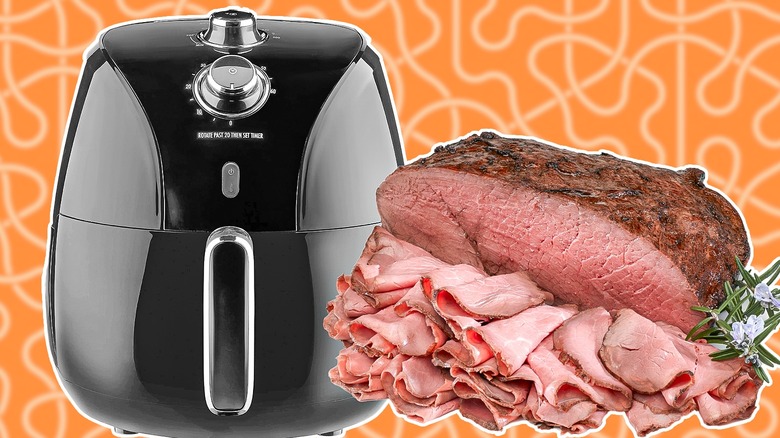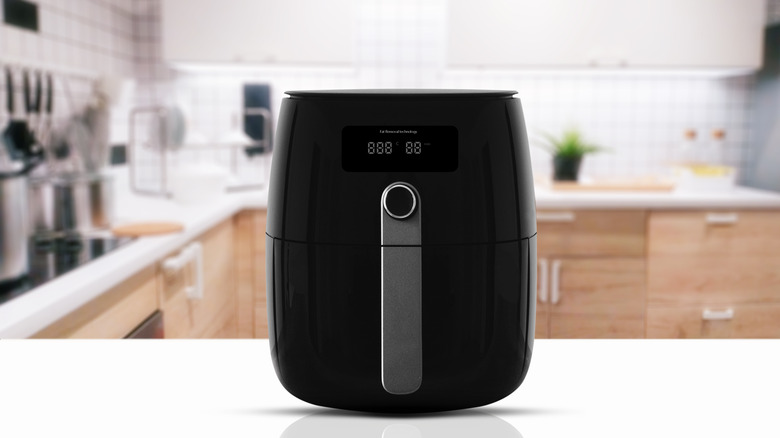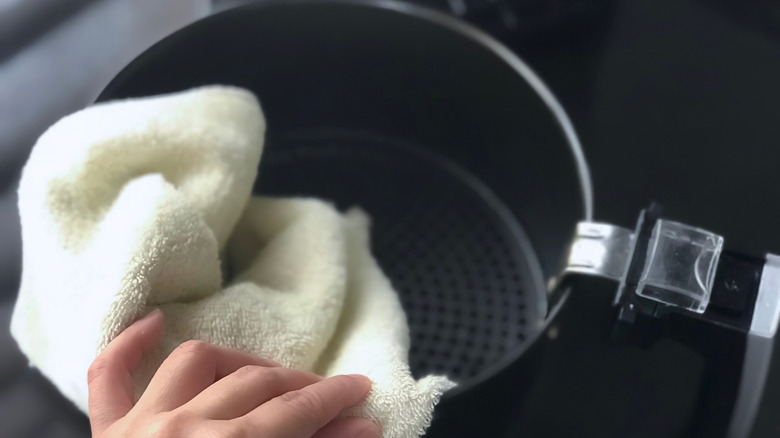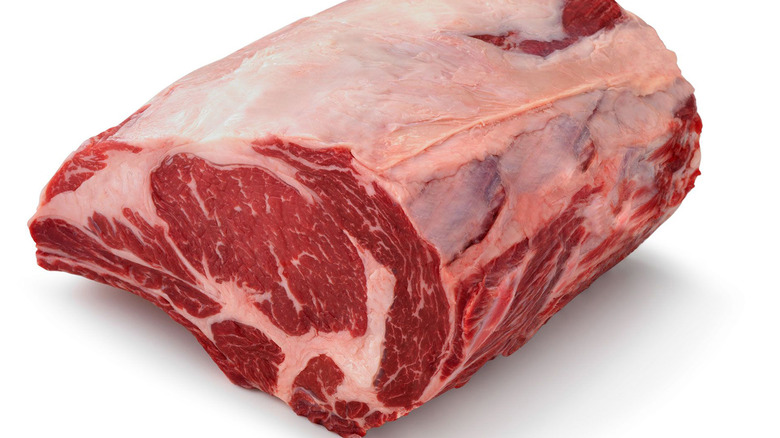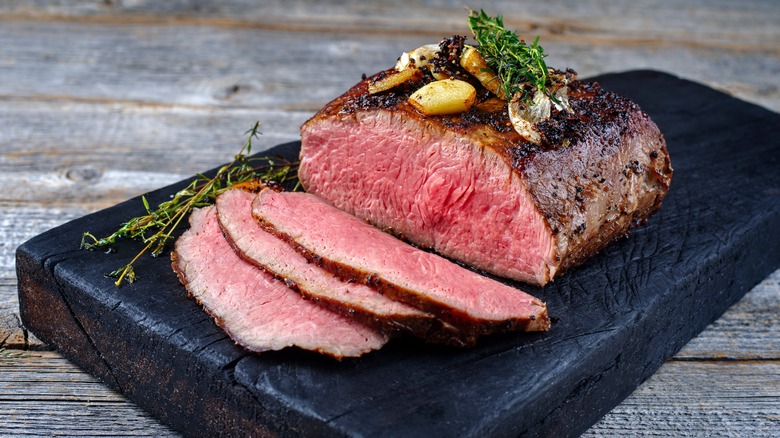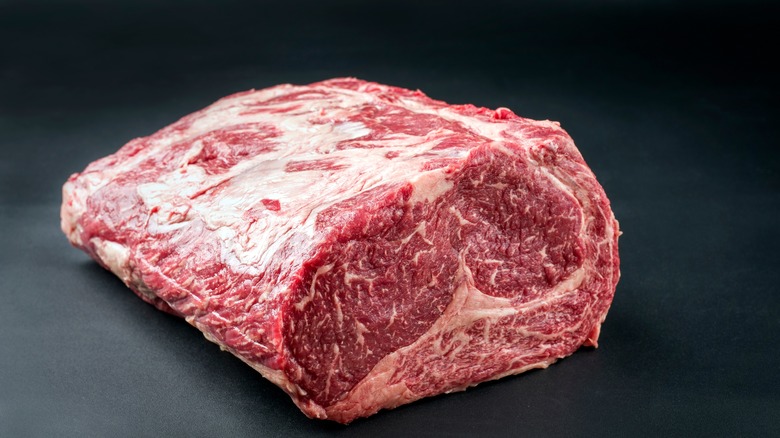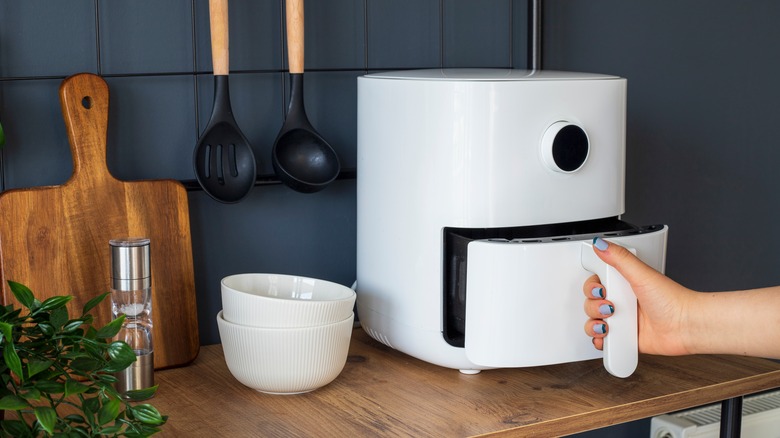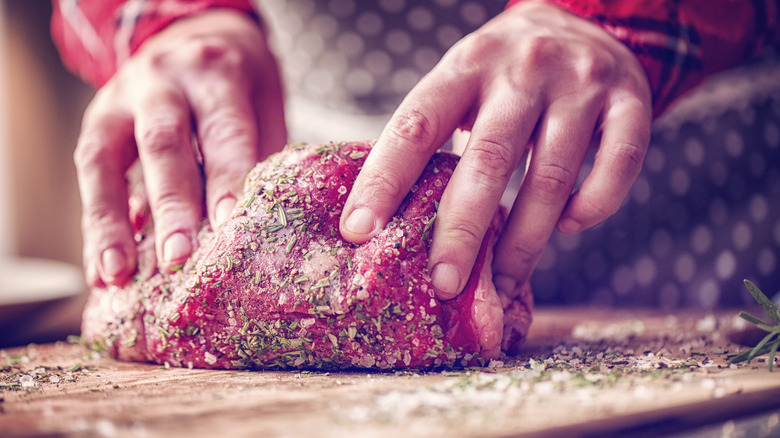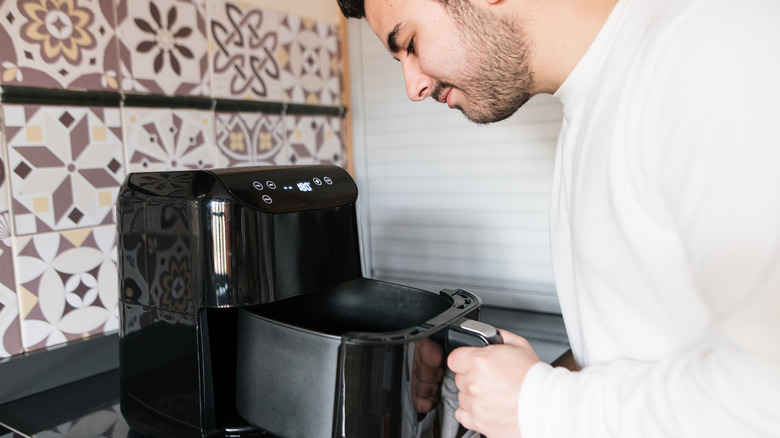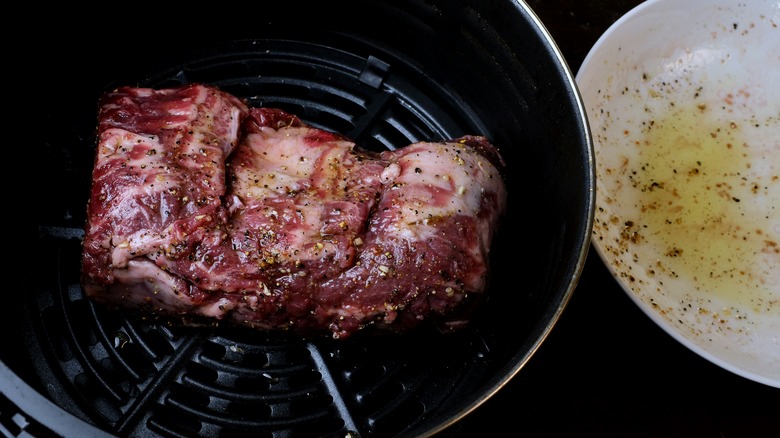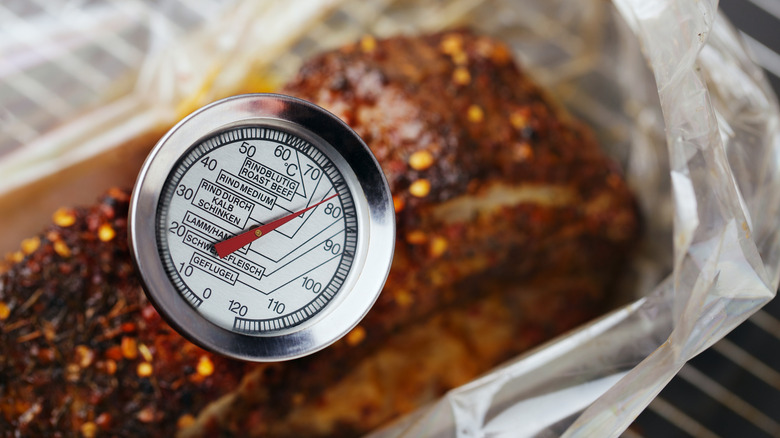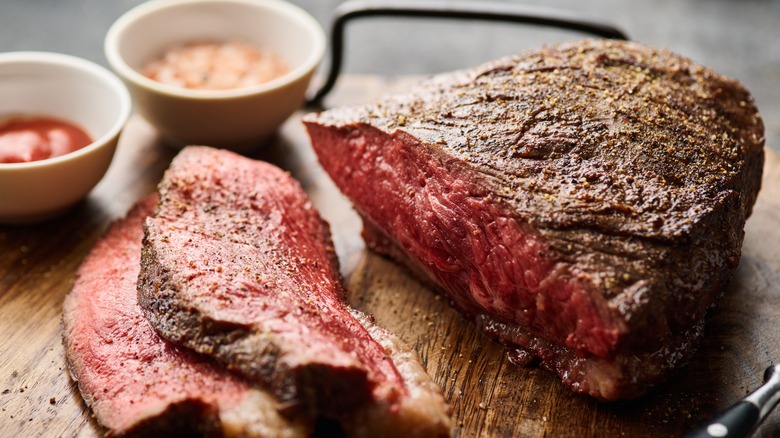11 Tips You Need For Cooking Roast Beef In The Air Fryer
Roast beef is the consummate cozy, comfort meal. There's not much better than beef cooked to tender perfection, ready to be sliced for a traditional roast beef sandwich, a roast beef po'boy, or served alongside your favorite vegetables. It's a hearty and satisfying dish that makes it easy to feed and please a crowd.
The only downside to a typical roast beef dinner is the time it takes to get it on the table. Cooking roast beef requires several steps: seasoning the meat, searing it, and then building a flavorful liquid to braise the roast in. This process can take more than two hours, depending on the size of your roast. The result is delicious but somewhat time-consuming. If you want to serve up fantastic roast beef in half the time, turn to your trusty air fryer.
Air fryers are a staple appliance in many kitchens. As a chef and recipe developer, I have used mine extensively to create dishes that are flavorful and fast. They have revolutionized the way we cook, and their convenience and simplicity make it simple to complete a variety of culinary tasks, from reheating leftovers to cooking everything from bacon to chicken wings. If you're willing to think outside the oven, you'll find your air fryer is a terrific choice for cooking roast beef. The best part? Air fryers can give you a flavorful, tender roast beef in under an hour. Follow these tips for the best air fryer roast beef.
Choose the right size air fryer
There's more to buying an air fryer than you might think. Convenience, how easy it is to clean, and how well it matches your kitchen decor are all important aspects, but when choosing an air fryer, size is also a critical characteristic to consider. You should think about both the size of the actual air fryer and the number of people you'll be cooking for before purchasing an air fryer. They are not one-size-fits-all appliances. If you anticipate using an air fryer to prepare daily dinners for a family of eight, you shouldn't choose the same size as someone using the fryer to reheat leftovers for a family of two. A small air fryer won't allow you to use it to prepare larger items, like roast beef.
Logistics aside, using the wrong-size air fryer can also have a negative impact on the food you're cooking. Air fryers work much like convection ovens by surrounding food with hot air. If your roast beef is too large for your air fryer, there's less room for the air to circulate, so your food won't brown well or cook evenly. Your roast beef should easily fit into the basket of your air fryer with plenty of room between it and the sides of the basket.
Make sure air fryer is clean
You wouldn't eat your dinner on a dirty plate, and you shouldn't cook your food in a dirty air fryer. Unlike some kitchen appliances, an air fryer should be cleaned after every use. Washing your air fryer should be as much a part of your routine in the kitchen as washing the pan you sauteed your veggies in or the pot you simmered your bolognese in. The idea of reusing those pots and pans without cleaning them is unimaginable because dirty pans can lead to foodborne illness. A dirty air fryer can be dangerous, as well.
Germs aside, a dirty air fryer can cause other problems if you don't make sure it's clean before each use. Most air fryers use a basket or rack to rest your food on. As the food cooks, any juices or oils drain to the bottom of the machine. Tiny bits of food can also fall to the bottom of your air fryer. Over time, this buildup of oil and food can start to smoke as your air fryer heats up.
This oily food debris can also force your air fryer to work harder to operate at full capacity. It can also cause your air fryer to take longer to reach your desired temperature. Worst of all, any food added to a dirty air fryer can take on the taste of the remnants left behind from previous use.
Choose the right cut of beef
Choosing the best cut of meat is a crucial step in cooking a perfect roast beef in the air fryer. All beef roasts are not created equal, and the cut of meat will affect your roast's taste and texture.
One of the benefits of a traditional roast beef dinner is the ability to choose an inexpensive, tough cut of meat. The longer roasting process required to cook a roast gives your oven plenty of time to tenderize your roast. When properly roasted and sliced thinly, a tough cut of meat can turn into a mouthwateringly tender bite. The same rules don't apply when you're cooking a roast in the air fryer.
When cooking your roast in the air fryer, you'll have to take other factors into consideration to achieve the same delicious result. Foods cooked in the air fryer can easily dry out, so it's essential to choose tender roasts with lots of marbling. Marbling is the thin strings of fat that run through the meat. It helps keep the meat moist as it cooks.
The air fryer's shorter cooking time means tougher cuts of meat won't have hours to tenderize, so it's crucial that you choose a roast with significant marbling. Some great recommendations include cuts like top sirloin, tenderloin, and Tri Tip roasts for use in the air fryer.
Pat roast dry before cooking
A tender, juicy center that practically melts in your mouth and a crispy, brown exterior are the hallmarks of a perfectly cooked roast beef. The delectable contrast in textures between the crunch on the outside and the delicate meat in the center is the gold standard, and it doesn't happen by accident. The crust is formed from either searing the roast if it's on the small size or roasting it at a high temperature for larger pieces of meat. Even these techniques will fail if you skip one simple but crucial step — patting your roast dry before cooking it.
In order to form a crust on your roast beef, it has to be exposed to high temperatures. If the surface of the roast is wet, the steam that will inevitably appear when your roast hits the pan or the hot oven will prevent a crust from forming. You won't get the beautiful brown color or the wonderful flavors that develop as the Maillard reaction occurs. Your roast will cook but won't have the savory crust you crave.
Before you start your roast, grab a paper towel or two and gently press it against the roast. The goal is to remove any moisture on the surface of the roast. Don't press too hard, or you'll also start to absorb the juices inside the meat. This will likely lead to a roast that's dry and off in texture.
Bring roast to room temperature before cooking
What do roast beef and cookies have in common? If you spend any time reading recipes, you've likely seen room temperature more times than you can count. In baked goods, cooks are instructed to allow ingredients like eggs and butter to come to room temperature before using them because they are better able to mix when they've had a chance to warm slightly and soften. The same thing is true with roast beef.
A refrigerated roast should be cold to its core if it's been stored properly. If your goal is to cook your roast to a proper cooking temperature, a minimum internal temperature of 145 F for beef, starting with a roast fresh out of the fridge, will take longer to warm up to the appropriate temperature. In the meantime, the outside of your roast can potentially dry out. Letting your roast come to room temperature speeds up the cooking process, making it less likely the crust will burn or dry out.
To bring your roast beef to room temperature, simply remove it from the fridge before you cook it. The length of time it takes your roast to reach room temperature will depend on its size. Larger roasts will take longer than smaller ones. Generally, you can leave a roast on your counter for up to two hours safely, so long as your kitchen isn't 90 F or higher.
Preheat air fryer
Air fryers are known for their convenience and efficiency in the kitchen. You can cook food fast and enjoy delicious results in a matter of minutes. Their quick cooking times, consistent results, and the ability to prepare food without turning on the oven have made them an appliance many cooks rely on. Air fryers have one thing in common with traditional ovens: They both usually require preheating for the best outcomes.
We all preheat our ovens before we bake a cake to give the oven an opportunity to reach the ideal temperature. The same rule applies to your air fryer in most instances. Preheating your air fryer circulates hot air, ensuring that you're placing your roast in an evenly heated environment. The temperature will be the same throughout the fryer, which promotes even cooking. For roast beef, the hot air that preheating your air fryer produces will also help create a savory crust on your roast.
To find out if you should be preheating your air fryer, check your air fryer's instruction manual for preheating directions specific to your machine, or simply turn on the air fryer at the temperature you'll be cooking at and allow it to run for two to four minutes before adding your roast.
Season roast generously
Seasoning your food should be part of your regular routine in the kitchen. It's a way to make sure whatever you're cooking tastes like the most spectacular version of itself. For most recipes, it's always a good idea to start with salt and pepper, but there are a multitude of herbs and spices that will make the perfect rub for your air fryer roast beef. When considering seasonings for roast beef, include everything from garlic powder to paprika. Think outside your spice rack and add in a little brown sugar to give your roast a hint of sweetness.
Adding dry herbs and spices directly to your roast can be tricky. Gravity will cause some of your seasonings to fall off your roast once you place it in the air fryer, so it's important to be generous with the seasonings to compensate for that potential loss of flavor. The goal is that every bite of your roast is equally seasoned and delicious. Because air fryers operate by circulating hot air throughout the machine, you'll find that air can blow some of your herbs and spices off your roast. To prevent this, mix your herbs and spices with a little olive oil until it's a paste-like consistency. You can then spread this all over your roast. The oil will help the seasonings stick to your roast, and together, they'll contribute to your roast's crust.
Get the cooking temperatures right
Whether you're cooking your roast beef in an oven or an air fryer, you must get the temperature right to cook it perfectly. An air fryer can produce the same deliciously brown and crisp roast beef you get from an oven with a few adjustments.
If you don't have a roast beef recipe specifically for air fryers, you can make a conventional recipe air fryer-friendly in just two steps. First, you'll need to adjust the cooking temperature. The circulating hot air in your air fryer can cause it to run hotter than a conventional oven. To account for that, you'll have to adjust the temperature you cook your roast for the best results.
A general rule is to cook your roast beef at a temperature that's 25 F less than you would in a conventional oven. You'll also need to adjust your cooking time, reducing it by 20 – 25%. If your traditional roast beef recipe directs you to cook your roast at 425 F for one hour, the air fryer version will cook at 400 F for 45 – 50 minutes, depending on how well you like your beef cooked.
Flip roast halfway through cooking
Air fryers are known for their ability to cook food evenly. The air circulating through the basket ensures that, unlike an oven, there are no hot spots, and your food cooks, crisps, and browns evenly on all sides. In a conventional oven, you can rotate your pans for even cooking.
Even cooking is a critical element when you're air-frying roast beef. It's especially important when you're working with a larger piece of meat. Many air fryer recipes call for shaking the basket during cooking to gently rotate the food during cooking to make sure it cooks evenly. Shaking the basket when you're cooking a roast beef won't work. Its size will prevent it from rotating.
Flipping your roast beef halfway through cooking will set you up for success. Flipping or rotating meat is not uncommon. Get into the habit of flipping your roast beef about halfway through the cooking process for two reasons. First, it will expose all sides of your roast to the hot air. Even with the constant circulation of air inside your air fryer, the meat touching the bottom of the basket won't benefit from that air as much as the sides that aren't touching the basket. Turning the meat solves this problem. By rotating your roast beef as it cooks, you're giving the center of your roast equal access to the hot air so it cooks evenly, as well.
Use a meat thermometer to get the temperature right
There are some things in cooking where precision is not essential, and you have a little wiggle room to freestyle or eyeball certain aspects of your recipe. You can eyeball the amount of seasoning you add to a pot of soup or guesstimate the amount of time a stew should simmer, usually without negatively impacting your final dish. When you're cooking proteins, especially meat and poultry, precision is key. You want your roast to be cooked to your personal desired level of doneness, and equally important, you want to make sure your roast is safe to eat.
Roast beef should be cooked to a minimum internal temperature of 145 F to prevent food-borne illness. This temperature will give you a medium roast. You can cook your roast to a higher temperature to reach medium well, 150 F, or well done, 160 F.
The only way to accurately confirm your roast beef's internal temperature is to use a meat thermometer. Insert the thermometer into the thickest part of your roast before removing it from your air fryer to precisely measure the temperature. The center of your roast will be the last part of the meat to reach your ideal temperature, so it's important that the thermometer is inserted here for an exact temperature reading.
Let the roast rest
After you've cooked your roast beef to perfection, you might think your work is done, but there's one final task you need to complete. It's a simple task that, if not done correctly, can ruin your roast, negatively affecting its texture and juiciness. It's also often the hardest thing for some people to do because they want to dig into their roast immediately.
If you want to finish your roast beef in a way that preserves your caramelized crust and tender, juicy center, give it a rest. There are two primary reasons why you let meat rest. Resting helps the meat maintain its juiciness. If you've ever sliced a roast and ended up with a puddle of juices on your cutting board, it's likely because you didn't let your roast rest before slicing it. Resting allows all of the roast's internal juices, which bubble up to the surface during cooking, to redistribute themselves throughout the meat so they're less likely to end up on your cutting board, leaving you with a dry piece of meat.
Resting also helps make sure your roast reaches the proper temperature. If you've removed your roast from the air fryer a few degrees before your ideal temperature, resting allows your roast to take advantage of its residual heat to continue cooking to reach the right temperature.
Some chefs recommend resting your meat for one minute for every 3.5 ounces of your roast's weight. Generally, 10 to 20 minutes is sufficient.
